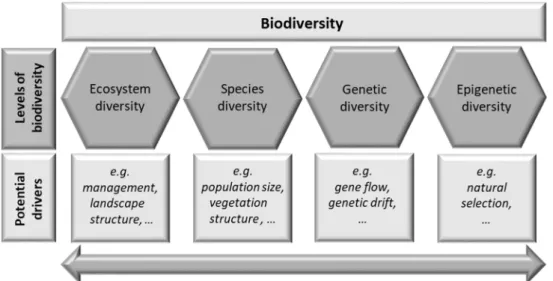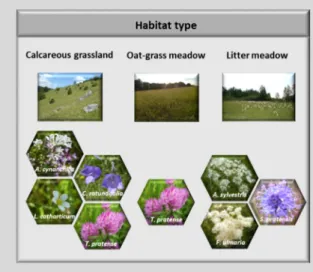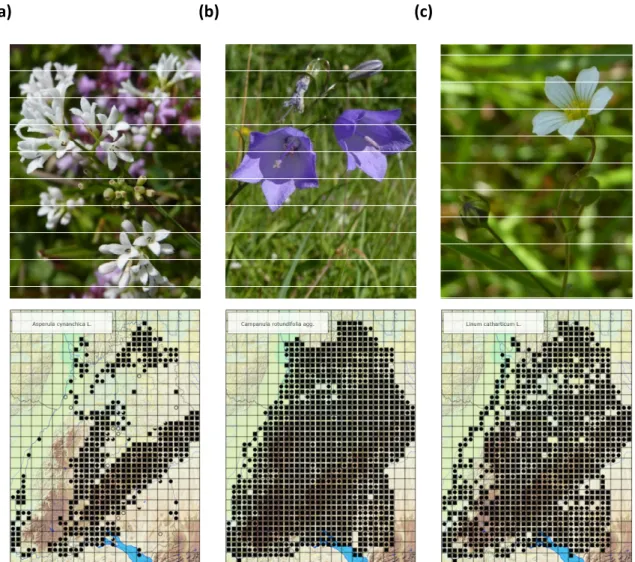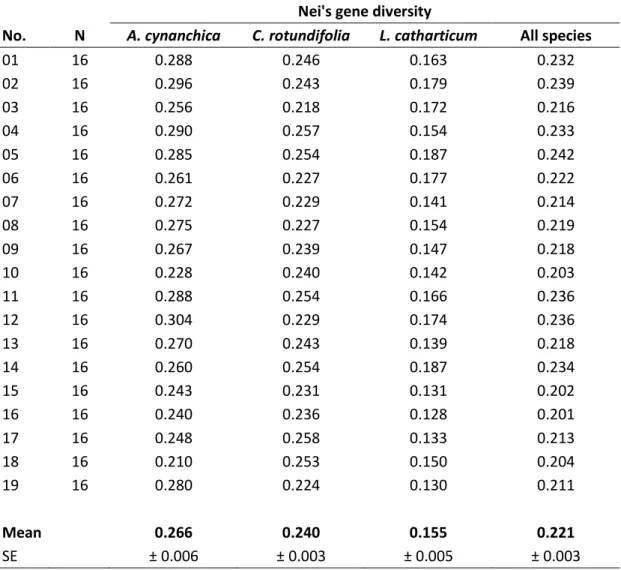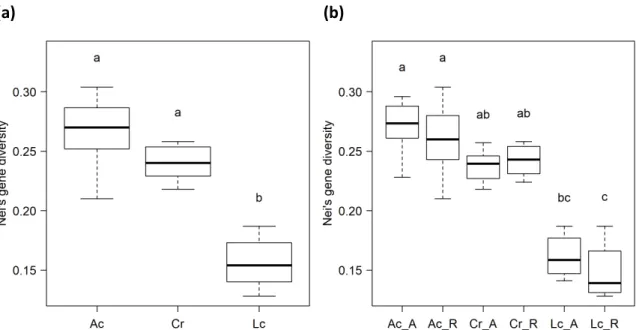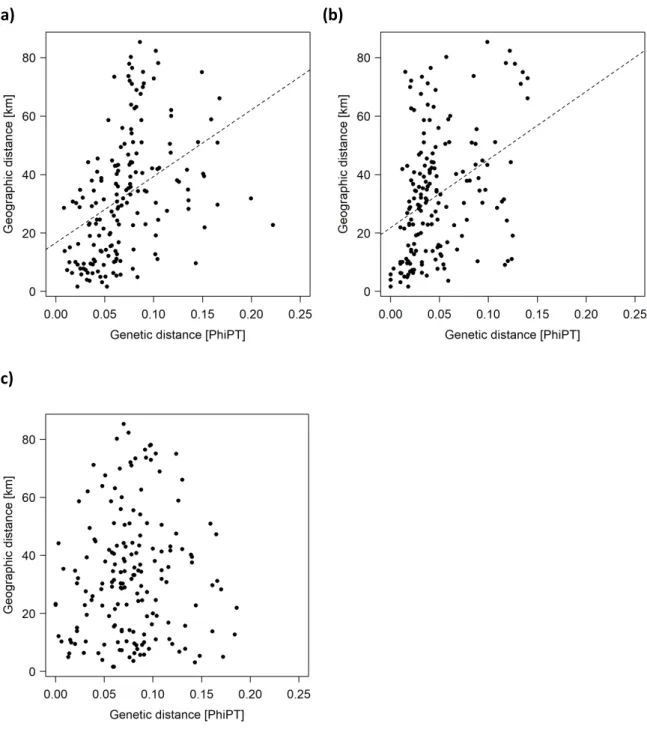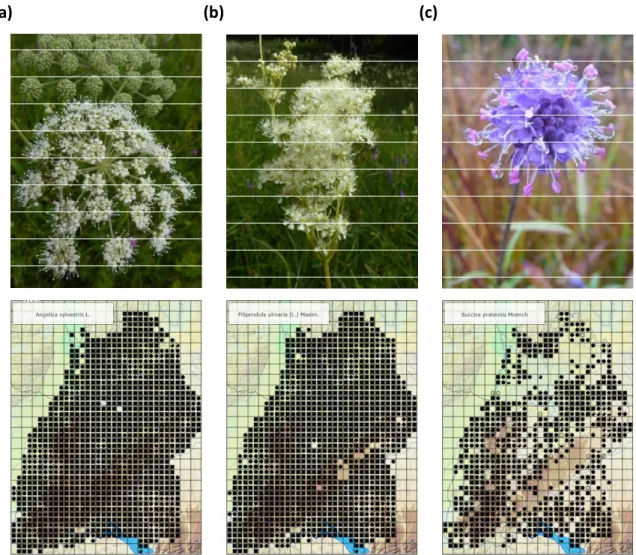Biodiversity conservation in semi-natural grasslands – The significance of genetic and epigenetic variation
D
ISSERTATION ZURE
RLANGUNG DESD
OKTORGRADES DERN
ATURWISSENSCHAFTEN(D
R.
RER. N
AT)
DER
F
AKULTÄT FÜRB
IOLOGIE UNDV
ORKLINISCHEM
EDIZIN DERU
NIVERSITÄTR
EGENSBURGVORGELEGT VON
THERESA ANNA LEHMAIR AUS DACHAU
IM JAHR2020
iii Das Promotionsgesuch wurde eingereicht am: 14.02.2020
Die Arbeit wurde angeleitet von: Prof. Dr. Christoph Reisch
Unterschrift:
Theresa Anna Lehmair
iv
v
I
F YOU CAN DREAM IT,
YOU CAN DO IT.
(Walt Disney)
Menyanthes trifoliata L.
vi
vii THIS THESIS IS COMPOSED OF THE FOLLOWING MANUSCRIPTS, WHICH ARE LARGELY IDENTICAL WITH THE MANUSCRIPTS SUBMITTED FOR PUBLICATION:
CHAPTER 2
Theresa Anna Lehmair, Ellen Pagel, Peter Poschlod, and Christoph Reisch. The impact of habitat age, landscape structure, habitat quality, and population size on the genetic variation of typical calcareous grassland plant species. Submitted to Landscape Ecology.
Author contributions: CR and PP conceived and designed the study. TAL and EP collected the data and performed the genetic analyses. TAL analysed the data and wrote the manuscript. EP, PP, and CR revised the article. All authors read and approved the final manuscript.
CHAPTER 3
Theresa Anna Lehmair, Ellen Pagel, Peter Poschlod, and Christoph Reisch. Genetic variation of litter meadow species reflects gene flow by hay transfer and mowing with agricultural machines. Accepted for publication in Conservation Genetics.
Author contributions: PP and CR conceived and designed the study. TAL and EP contributed equally to the manuscript by collecting the data, performing the data analyses, and writing the manuscript. PP and CR revised the manuscript. All authors read and approved the final manuscript.
CHAPTER 4
Theresa Anna Lehmair, Peter Poschlod, and Christoph Reisch. The impact of environment on genetic and epigenetic variation of Trifolium pratense L. populations in two contrasting Central European grasslands. Submitted to PLoS ONE.
Author contributions: PP and CR conceived and designed the study. TAL collected the data, performed the genetic analyses, analysed the data, and wrote the manuscript. PP and CR revised the article. All authors read and approved the final manuscript.
viii
MANUSCRIPTS NOT INCLUDED IN THIS THESIS:
Ellen Pagel, Theresa Anna Lehmair, Peter Poschlod, and Christoph Reisch. Genetic variation of typical plant species in oat-grass meadows: The effect of land use history, landscape structure, and habitat quality. Submitted to Journal of Applied Ecology.
Author contributions: CR and PP conceived and designed the study. TAL and EP collected the data and performed the genetic analyses. EP analysed the data and wrote the manuscript. TAL, PP, and CR revised the article. All authors read and approved the final manuscript.
ix
T
ABLE OFC
ONTENTSSummary xi
CHAPTER 1
General Introduction 1
CHAPTER 2
The impact of habitat age, landscape structure, habitat quality, and population size on the genetic variation of typical calcareous grassland plant species 13
Abstract... 14
Introduction ... 15
Methods ... 18
Results ... 23
Discussion ... 29
Conclusions ... 34
CHAPTER 3 Genetic variation of litter meadow species reflects gene flow by hay transfer and mowing with agricultural machines 35 Abstract... 36
Introduction ... 37
Methods ... 41
Results ... 46
Discussion ... 50
Conclusions ... 55
x
CHAPTER 4
The impact of environment on genetic and epigenetic variation of Trifolium
pratense L. populations in two contrasting Central European grasslands 57
Abstract... 58
Introduction ... 59
Methods ... 62
Results ... 68
Discussion ... 75
Conclusions ... 79
CHAPTER 5
General Discussion and Conclusions 81
Acknowledgements 97
References 99
1 Supplementary Material - DNA extraction, AFLP and MSAP analyses 117
2 Supplementary Material - Chapter 2 123
3 Supplementary Material - Chapter 3 131
4 Supplementary Material - Chapter 4 139
SUMMARY
xi
S
UMMARYIn Europe, semi-natural grasslands are characterized by an outstanding species-richness and an enormous ecosystem diversity. Abandonment of traditional land use practices led to a biodiversity decline on an unprecedented scale during the last decades. Consequently, the Habitats Directive was initiated to protect semi-natural grasslands and some of their characteristic species. Besides ecosystem and species diversity, comprehensive biodiversity conservation should also address genetic diversity. However, plant genetic resource conservation is usually not included in biodiversity conservation strategies and thus, effective conservation of plant genetic diversity is still in its infancy. Plant genetic resources should be properly understood to ensure the development of applicable conservation methods. Hence, the knowledge of the species’ taxonomy, origin, and evolution as well as its major drivers of genetic variation are of central importance. Therefore, the present study focused on potential explanatory variables for genetic variation in six common semi- natural grassland plant species. Furthermore, the impact and extent of rapid DNA methylation patterns was examined in contrast to comparatively slow alterations of the genetic code between two contrasting habitats.
Chapter 1 provides a brief overview about the importance of semi-natural grassland habitats and their species’ (epi)genetic variation against the background of biodiversity decline and conservation.
In the following two chapters, amplified fragment length polymorphism (AFLP) analyses were applied to identify potential drivers of genetic variation. More specifically, the impact of habitat age, surrounding landscape structure, local habitat quality, and population size on genetic diversity and differentiation was tested.
In chapter 2, the genetic composition of three common and widely distributed calcareous grassland plant species, Asperula cynanchica L., Campanula rotundifolia L. s. str., and Linum catharticum L., was investigated. No crucial impact of habitat age, habitat quality, or population size was observed. However, the distance to the nearest settlement, the total area of calcareous grasslands, and their connectivity turned out as key drivers of genetic diversity. Genetic diversity, therefore, strongly depended on the surrounding landscape structure. Since landscape structure is indirectly shaped by land use,
SUMMARY
xii
our study supports the observation that genetic variation is strongly affected by grazing and thereby arising gene flow patterns.
Moreover, the genetic composition of Angelica sylvestris L., Filipendula ulmaria (L.) Maxim., and Succisa pratensis MOENCH populations in litter meadows was examined in chapter 3. Habitat age revealed no influence on genetic variation patterns again. The impact of landscape structure, habitat quality, and population size on genetic diversity depended on species affiliation. Distance to the nearest settlement, habitat size, the total area of wet meadows, and their connectivity shaped genetic diversity patterns of A. sylvestris and F. ulmaria populations. Local habitat quality affected, moreover, the genetic diversity of F. ulmaria, while genetic diversity of S. pratensis populations was driven only by population size. The history of origin, but also current mowing with agricultural machines, caused and still cause gene flow among litter meadow populations. Hence, all explanatory variables underlay anthropogenic land use patterns and thereby arising man- made gene flow.
Chapter 4 focused on potential differences in genetic and epigenetic variation patterns of Trifolium pratense L. between two contrasting semi-natural grassland habitats, calcareous grasslands and oat-grass meadows. An additional objective was to identify possible drivers of genetic and epigenetic variation. By conducting AFLP and MSAP (methylation-sensitive amplification polymorphism) analyses, low levels of genetic and epigenetic differentiation among populations and between habitat types were observed. Genetic variation was significantly isolated by habitat dissimilarity, while epigenetic variation was not. Habitat affiliation revealed no significant impact on genetic or epigenetic diversity. Furthermore, genetic diversity was not affected by environment, while epigenetic diversity levels correlated significantly with soil moisture and soil pH.
Genetic and epigenetic variation were not interdependent and thus, shaped by different environmental conditions. On the one hand, genetic variation was influenced by habitat specific environmental conditions induced by land use related disturbance and gene flow patterns. On the other hand, epigenetic variation was driven by challenging environmental conditions decreasing under drought and high pH, with the latter potentially resulting in phosphorus limitation.
SUMMARY
xiii In chapter 5, all findings were recapitulated and placed in the context of in situ plant genetic resource conservation. Strengths and limitations of all analyses were highlighted against the background of genetic reserve identification, establishment, and maintenance.
The chapter dealt, moreover, with perspectives for future scientific research. Thus, a multi- species approach on a larger spatial scale may exclude ecologically determined variation and allow genetic resource conservation above species level. Additionally, both genetic and epigenetic variation patterns should be integrated in the process of genetic reserve identification to add a new dimension of complexity to the diversity and evolutionary potential of natural populations. International exchange of knowledge may, moreover, ensure and facilitate sustainable genetic resource conservation.
xiv
CHAPTER 1
1
C
HAPTER1
G
ENERALI
NTRODUCTIONCentaurea jacea agg.
CHAPTER 1
2
Biodiversity, the variety of life, covers the entire biological hierarchy from molecules to ecosystems including individuals, genotypes, populations, species, etc. and all their interactions (Sarkar & Margules, 2002). The Convention on Biological Diversity (CBD, 1992) classified three levels of diversity: (i) ecosystem diversity (communities of species and their environment), (ii) species diversity (species richness), and (iii) genetic diversity (variation in genotypes and genes) (Figure 1.1) (Ramanatha Rao & Hodgkin, 2002). Moreover, biodiversity stands for the availability of natural resources for plant and animal breeding or genetic and medical engineering (Haila & Kouki, 1994). Thus, it represents a key component of sustainable development in social and economic human systems (Ramanatha Rao &
Hodgkin, 2002). Nevertheless, human appropriation of natural resources, spread of pathogenic, exotic, and domestic animals and plants as well as modifications of habitats and climate reveal major threats to biodiversity (Naeem et al., 2012). As a consequence, ecosystems are rapidly losing functional, taxonomic, phylogenetic, and genetic diversity all over the world (Naeem et al., 2012).
Figure 1.1: Levels of biodiversity and their potential drivers.
In Europe, semi-natural grasslands (Box 1.1) constitute the most diverse ecosystems hosting 18.1 % of Europe’s endemic vascular plant species (Hobohm &
Bruchmann, 2009) as well as a large proportion of the vertebrate and invertebrate fauna, e.g. two-thirds of the butterfly species (WallisDeVries & Van Swaay, 2009). Besides species-
CHAPTER 1
3 richness, semi-natural grasslands provide a great amount of ecosystem services. Four main groups were defined by the Millennium Ecosystem Assessment (2005) and Hopkins (2009) highlighted the most important ones for semi-natural grasslands: (i) provisioning services:
products (herbs, honey, dairy products, and meat), genetic material (seeds), and fresh water; (ii) supporting services: carbon fixation, soil formation, nutrient and water cycling;
(iii) regulating services: stabilization of the natural environment by regulated air and water quality, soil erosion, and water run-off; and (iv) cultural services: aesthetic value and recreation areas. Therefore, semi-natural grasslands appear as key areas for biodiversity conservation in Europe (Raatikainen et al., 2009; Rosengren et al., 2013).
European semi-natural grasslands developed due to human activities (e.g. grazing, mowing, and burning) during the Anthropocene (Poschlod & WallisDeVries, 2002).
Centuries of extensive, traditional land use led to an exceptional high species diversity (Figure 1.2) (Butaye et al., 2005; Poschlod & WallisDeVries, 2002). Nevertheless, semi- natural grasslands significantly decreased through traditional management abandonment during the last century (Poschlod et al., 2005). In 1998, Muller et al. (1998) named serious threats to semi-natural grasslands, which are still relevant. On the one hand, intensified grassland management with increased fertilizer application, early cutting, ploughing, drainage, or high grazing pressures homogenized species composition. On the other hand, abandonment led to a dominance of competitive species, eutrophication, and in many cases to subsequent reforestation. Besides management induced changes, semi-natural grasslands are destroyed by anthropogenic construction projects like highways, dams, or for leisure facilities. Atmospheric nitrogen deposition and invasive species constitute further threats (Habel et al., 2013).
CHAPTER 1
4
Figure 1.2: Relationship between polarization (towards intensification as well as abandonment) of agriculture and biodiversity values in semi-natural grasslands. Missing or intensified management decreases the conservation value regarding biodiversity. (Ostermann 1998; edited by Lehmair)
Semi-natural grasslands are subjected to similar threats by modern land use practices, although their ecosystems are characterized by different environmental settings (Box 1.1). These threats reduce habitat quality and quantity by pure habitat loss, individual patch size decline, and increasing fragmentation (Andrén, 1994; Poschlod & Schumacher, 1998). Consequently, even populations of common plant species become fewer, smaller, and more distant (Picó & Van Groenendael, 2007). They show reduced fitness levels due to several factors lowering genetic variation, such as limited pollen and seed dispersal, genetic drift, and inbreeding (Leimu et al., 2006; Luijten et al., 2000; Vergeer et al., 2003). In short term, small and fragmented populations become more susceptible to pathogens and herbivores (Brown, 1983; Ellstrand & Elam, 1993). In long term, their extinction risk increases especially among demographic stochasticity and unpredictable environmental conditions (Picó & Van Groenendael, 2007). Hence, fragmentation and downsizing of habitat patches jeopardise the persistence of highly diverse semi-natural grasslands (Fahrig, 2003; Raatikainen et al., 2009).
In response to these threats and to protect, inter alia, species-rich semi-natural grasslands, the European Commission passed the ‘Council Directive 92/43/EEC on the conservation of natural habitats and of wild fauna and flora’ (COM, 1992). A network of ecosystems with high conservation value, Natura 2000, was designed ‘to halt the loss of biodiversity and the degradation of ecosystem services in the EU by 2020, and restore them as far as feasible, while stepping up the EU contribution to averting global biodiversity loss’
(COM, 2011). Nevertheless, comprehensive biodiversity conservation should also address
CHAPTER 1
5 genetic diversity (Ramanatha Rao & Hodgkin, 2002), which constitutes another key variable of biodiversity (Figure 1.1) (Laikre et al., 2010; May, 1994; Naeem et al., 2012; Wilkox, 1984).
On individual level, genetic diversity depicts genetic differences among individuals varying in DNA sequence, biochemical characteristics, physiological properties, and morphological characters (Ramanatha Rao & Hodgkin, 2002). On population level, it stands for the number of different alleles per population, their distribution, and their impact on populations’ performance and distinctiveness (Ramanatha Rao & Hodgkin, 2002). Thus, genetic diversity represents the amount of genetic variation among individuals of populations, but also among populations of species (Brown, 1983). The variation that underpins genetic diversity is based on mutation processes, which are driven by recombination, genetic drift, gene flow, and natural selection (Ramanatha Rao & Hodgkin, 2002; Vellend, 2005).
When it comes to recombination, a species’ mating system significantly shapes the genetic composition of its populations (Schmitt, 1983). Selfing species are often highly differentiated among populations with different alleles occurring in different populations (Tachida & Yoshimaru, 1996). Outcrossing species show a high degree of intrapopulation genetic structure due to regular recombination events (Baatout et al., 1990). The strong dependence on suitable mating partners and a greater susceptibility to small population size reveal a positive association between mean genetic diversity and fitness for outcrossing, but less for selfing species (Leimu et al., 2006; Picó & Van Groenendael, 2007).
Genetic drift represents random variation in gene frequencies caused by varying intensity and direction of selection, mutation, and gene exchange among populations (Dobzhansky & Pavlovsky, 1957; Wright, 1949). Random drift is generally not expected to contribute in directed evolutionary processes (Dobzhansky & Pavlovsky, 1957), but in small and isolated populations, genetic drift may reduce heterozygosity, change the populations’
adaptive potential and their physiological optimum (Hooftman et al., 2003; Lande, 1976).
Site connection by pollination and seed dispersal may rescue populations from genetic erosion and thus, counteract genetic drift (Brown & Kodric-Brown, 1977).
CHAPTER 1
6
Gene flow provides new genetic material (new species or novel alleles at one or more loci) through pollen and seed dispersal (Vellend & Geber, 2005; Young et al., 1996).
Both pollen and seeds may connect existing populations over great distances. Additionally, seeds enable the founding of new populations (Mix et al., 2006). Nevertheless, the exchange of pollen and seeds among populations greatly depends on dispersal vectors (Mix et al., 2006). Thus, plant-pollinator interactions may be limited by habitat fragmentation, since pollinating insects may rarely travel distances larger than 1 km (Kwak et al., 1998;
Steffan-Dewenter & Tscharntke, 2002), while seed dispersal by animals may exceed distances of 100 km and more (Fischer et al., 1996; Manzano & Malo, 2006). However, gene flow among locally adapted populations could also provoke a short-term fitness decrease with non-local alleles increasing the migration load and thus, leading to outbreeding depression (Bradshaw, 1984).
Therefore, the interaction of gene flow and natural selection represents the adaptive potential of populations (McKay et al., 2005; Slatkin, 1985). Natural selection removes maladaptive alleles and increases mean population fitness by favouring locally adapted alleles (McKay et al., 2005). Thus, strong natural selection may overcome the effects of gene flow, which could limit or ‘swamp’ adaptive differentiation (McKay et al., 2005). Epigenetic variation (Figure 1.1), as a result of metastable DNA methylation, allows plant species to rapidly adapt and survive under challenging environmental conditions without changing their DNA sequence (Bossdorf et al., 2008; Herrera & Bazaga, 2011; Lira- Medeiros et al., 2010; Paun et al., 2010; Schulz et al., 2014, 2013; Wu et al., 2013).
Epigenetic markers may, therefore, display the effects of natural selection (Hirsch et al., 2012) better than molecular markers, which are (nearly) neutral to natural selection (McKay et al., 2005).
Nowadays, semi-natural grassland populations are often spatially isolated and highly fragmented. Genetic habitat fragmentation by limited pollen and seed exchange restricts gene flow patterns (Honnay et al., 2006; Schmitt, 1983; Steffan-Dewenter &
Tscharntke, 1999; Willerding & Poschlod, 2002) and increases, therefore, the likelihood of inbreeding depression, the accumulation of deleterious mutations, and the extent of genetic drift (Picó & Van Groenendael, 2007; Young et al., 1996). Consequently increased
CHAPTER 1
7 genetic differentiation and reduced genetic diversity (Barrett & Kohn, 1991; McKay et al., 2005) may lower individual plant fitness and thus, increase their extinction risk (Ellstrand
& Elam, 1993; Young et al., 1996). At worst, populations and even species may collapse due to genetic diversity loss (Frankham, 2005; Newman & Pilson, 1997). Hence, fragmented semi-natural grasslands suffer from species decline and changed community composition today (Butaye et al., 2005). Against the background of these threats, plant genetic resources should be properly understood, efficiently preserved, and carefully used (Ramanatha Rao & Hodgkin, 2002).
Nevertheless, plant genetic resources are usually not monitored (Laikre et al., 2010) and thus, most in situ or ex situ conservation efforts are conducted without sufficient information about genetic variation (Ramanatha Rao & Hodgkin, 2002). Keller et al. (2015) named several reasons for this gap in knowledge: comparable high costs of molecular analyses, limited understanding of how to implement findings about genetic composition in practical conservation strategies, and, above all, limited communication between scientists and practitioners. Thus, consistent national or regional biodiversity monitoring and the exchange of collected data are often constrained by inconsistent scientific methods and conservation aims (Pereira et al., 2013).
Effective conservation of plant genetic resources, either in situ or ex situ, and the development of applicable conservation methods need a profound scientific and technical basis. Guidelines for genetic resource collection, evaluation, and selective breeding should be defined against the background of taxonomy, origin, evolution, and, especially, the genetic composition of the species of concern (Ramanatha Rao & Hodgkin, 2002).
Moreover, these guidelines should consider the major drivers of genetic variation.
Population (e.g. population size) or species specific (e.g. ploidy, breeding system, and connectedness) drivers reveal a direct impact on genetic variation. Indirect drivers, such as anthropogenic measures, landscape structure, climatic, edaphic, and biotic environmental conditions, vary among ecosystems and affect species individualistically (Ramanatha Rao &
Hodgkin, 2002; Vellend & Geber, 2005).
Such guidelines should be determined for both ex situ (gene or field bank) and in situ (on-farm or wild) conservation measures, since genetic diversity, found in nature,
CHAPTER 1
8
represents a resource of enormous significance (Greene et al., 2014; IUCN et al., 1980).
Thus, plant material, which is extracted from natural populations and saved ex situ in seed banks, tissue cultures, and botanic gardens (Maxted et al., 2000), should constitute a backup for those diversity components, which might be lost in nature through environmental change (Li & Pritchard, 2009). Although ex situ conservation of plants dates back to the 16th century (Hurka et al., 2008), only 29 % of globally threatened plant species (IUCN, 2013) were included in ex situ conservation programmes in 2014 (Sharrock et al., 2014). Therefore, in situ preserved sites should be used complementarily to locate, monitor, and manage genetic diversity of natural and wild populations within defined areas for active long-term conservation (Maxted et al., 2000). ‘Genetic reserves’, for instance, may function as donor sites for habitat creation, restoration, or diversity enhancement providing seed material, species and habitat diversity with locally adapted, native ecotypes (Hopkins, 2009). During the last decades, in situ conservation methods were improved to support the dynamic conservation of plant populations (Jarvis & Hodgkin, 1999). However, even ‘genetic reserves’, which aim to protect the maximum range of genetic diversity with a minimal set of sites (Maxted et al., 2000), are often determined without knowledge of the genetic composition (Phillips et al., 2014). Although it is impossible to protect the gene pool of a species as a whole (Maxted et al., 2000), a high proportion of a species’ genetic resource could be protected by investigating and considering its genetic composition.
CHAPTER 1
9
Box 1.1: Calcareous grasslands, oat-grass meadows, and litter meadows as model ecosystems – Characteristics and threats
Three Natura 2000 priority habitat types (i) calcareous grasslands1, (ii) oat-grass meadows2, and (iii) litter meadows3 (Figure 1.3) appeared as promising model ecosystems to study plant (epi)genetic resources.
Figure 1.3: Habitat types and study species investigated in this thesis.
Calcareous grasslands above water-permeable limestone are characterized by steep slopes, shallow soils and thus, relative dry soil conditions (Wilmanns, 1955). Their existence dates back to the Neolithic (Dutoit et al., 2009; Kapfer, 2010) or Bronze Age (Poschlod & Baumann, 2010). Hence, they belong to the oldest semi-natural grassland habitats in Europe.
Grazing related disturbance by cattle, sheep, and goats shaped their heterogeneous soil and sward structure (Kapfer, 2010; Olff & Ritchie, 1998) and turned calcareous grasslands into the most species- rich plant community in north-west Europe (WallisDeVries et al., 2002). Nowadays, calcareous grasslands are often highly fragmented due to intensification or abandonment (Steffan-Dewenter &
Tscharntke, 2002). Consequently, many (often rare) calcareous grassland species are about to disappear or went extinct already (WallisDeVries et al., 2002).
Moderate grazing with sheep and goats may avoid shrub encroachment, create dispersal corridors for species and thus, maintain species-rich calcareous grasslands.
Flower rich oat-grass meadows represent one of the youngest, but the most common Central European meadow type (Ellenberg, 1963; Poschlod et al., 2009).
Traditional management consists of two (or three) cuttings per year and regular manure application to maintain productivity despite constant biomass removal (Poschlod, 2017; Poschlod et al., 2009). Their vegetation structure is even, since mowing affects all species simultaneously (Ellenberg, 1996). During the last decades, species-rich oat-grass meadows declined due to intensified management with early mowing in spring, mineral fertilizer application, and thus, increased cutting numbers (Janssens et al., 1998;
Kapfer, 2010). Abandonment, ploughing, and reforestation reveal further threats (Austrheim et al., 1999; Bastian, 2013; Critchley et al., 2002). A return to traditional meadow management with adjusted cutting times and extensive manure application may counteract this decline.
The need for straw, used as bedding in stables, led to the creation of litter meadows during the 18th and 19th century (Poschlod, 2017; Poschlod &
Biewer, 2005). The comparably young grassland habitats were established from fodder meadows or large wet- and peatlands on alkaline or acidic (periodically) wet sites (Poschlod & Biewer, 2005).
During the last decades, bedding in stables was replaced by slatted floors (Poschlod et al., 2009) and comparably cheap mineral fertilizer allowed the transformation of unproductive litter meadows into yield-rich fodder meadows (Poschlod, 2017). These changes made the cultivation of litter meadows redundant and thus, remaining sites are threatened by drainage, intensification, abandonment, and habitat fragmentation today (Billeter et al., 2002).
Maintaining a sufficient groundwater level and mowing once a year in late autumn may preserve species-rich litter meadows from extinction.
1 6210: Semi-natural dry grasslands and scrubland facies on calcareous substrates – Xerobromion and Mesobromion
2 6510: Lowland hay meadows - Arrhenatherion
3 6410: Molinia meadows on calcareous, peaty or clayey- silt-laden soils - Molinion caeruleae
[Source: https://www.bfn.de/en/activities/natura-2000/habitat- types-and-species/natura-2000- habitats-in-germany.html/
Applied 20 December 2019]
CHAPTER 1
10
Thesis outline
The Convention on Biological Diversity (CBD) has emerged as key driver in environmental policy since 1992 (Hopkins, 2009). The alarming biodiversity decline during the last decades (Hallmann et al., 2017; Pimm et al., 2014; Seibold et al., 2019) made the protection of biodiversity more than ever to an issue of regional and global security. In Europe, semi- natural grasslands constitute the most diverse ecosystems hosting nearly one fifth of Europe’s endemic vascular plant species (Hobohm & Bruchmann, 2009) and a large proportion of the vertebrate and invertebrate fauna (Hopkins & Holz, 2006). Moreover, they provide a great amount of ecosystem services (Hopkins, 2009). Semi-natural grassland habitats and some of their characteristic species are already protected by the Habitats Directive (COM, 1992), but comprehensive conservation of plant genetic resources is still in its infancy.
A clear understanding of genetic variation patterns is inevitable against the background of effective plant genetic resource conservation, e.g. in in situ plant genetic reserves. Therefore, the aim of this thesis was to answer the following questions: (i) What are the key drivers of genetic variation patterns in semi-natural grasslands? (ii) Is it possible to protect plant genetic resources above species level? (iii) What is the impact of the underlying habitat type? (iv) Is epigenetic variation affected by similar key drivers? (v) Is genetic and epigenetic variation interdependent?
Neutral molecular markers constitute a suitable tool to study gene flow and genetic drift. Therefore, amplified fragment length polymorphism (AFLP) analyses were applied to investigate selection neutral processes shaping the genetic variation of six calcareous grassland and litter meadow species and thus, to identify potential drivers of genetic variation. In contrast to previous studies about genetic variation and possible determinants (Falińska et al., 2010; Hensen & Wesche, 2006; Last et al., 2013; Münzbergová et al., 2013;
Prentice et al., 2006; Reisch & Poschlod, 2009), our investigations were based on a multi- species approach. The study of various plant species, which are characteristic for one habitat type, revealed important insights in the underlying processes driving genetic variation of these species and of their habitats. Moreover, a multi-layer approach addressed various potential drivers of genetic variation simultaneously. Thus, the
CHAPTER 1
11 concurrent study of land use history, surrounding landscape structure, local habitat quality, as well as population size may allow the identification of the key components driving genetic variation in semi-natural grassland plant species.
Nowadays, environmental conditions continuously change and plant species need to react immediately to survive especially challenging environmental conditions. Cytosine methylation provides a fast and valuable tool for plant species to regulate transposon silencing and gene expression without changing the underlying genetic code. Therefore, methylation-sensitive amplification polymorphism (MSAP) analyses were conducted to compare metastable, but heritable DNA methylation patterns in calcareous grassland and oat-grass meadow populations. AFLP analyses were applied, moreover, to enable a comparison between the genetic and epigenetic composition of the study species. In contrast to previous studies about (epi)genetic variation and possible determinants, this study includes a comprehensive analysis of habitat specific on-site environmental conditions to address their impact on (epi)genetic variation.
Finally, the results of this thesis were placed in the context of in situ plant genetic resource conservation. Strengths, limitations, and perspectives of the analyses were highlighted and further research approaches were suggested to facilitate efficient identification, establishment, and maintenance of future in situ plant genetic reserves.
12
CHAPTER 2
13
C
HAPTER2
T
HE IMPACT OF HABITAT AGE,
LANDSCAPE STRUCTURE,
HABITAT QUALITY,
AND POPULATION SIZE ON THE GENETIC VARIATION OF TYPICAL CALCAREOUS GRASSLAND PLANT SPECIESTheresa Anna Lehmair, Ellen Pagel, Peter Poschlod, and Christoph Reisch
Calcareous grassland (No. 01) near Bichishausen, Germany
CHAPTER 2-ABSTRACT
14
Abstract
Land use change caused an ongoing decline of calcareous grasslands throughout Europe during the last decades. Subsequent habitat deterioration affects not only species diversity, but also the genetic variation of these species. Thus, the aim of our study was to identify the drivers of genetic variation in common calcareous grassland plant species. More specifically, we tested whether genetic diversity or differentiation of Asperula cynanchica, Campanula rotundifolia, and Linum catharticum depend on habitat age, landscape structure, habitat quality, and/or population size.
In our study we observed no significant influence of habitat age on genetic diversity and differentiation. Habitat quality also had no impact on genetic diversity and population size only showed weak effects. However, genetic diversity strongly depended on landscape structure represented by distance to the nearest settlement, total area of calcareous grasslands, and their connectivity.
Since landscape structure is indirectly shaped by land use, our study supports the observation that genetic variation is strongly affected by grazing patterns. Thus, moderate grazing intensities over long time seem to increase levels of genetic diversity, which in turn suffers from periods of overgrazing or abandonment.
Key words
AFLP; calcareous grassland; genetic variation; Asperula cynanchica; Campanula rotundifolia; Linum catharticum
CHAPTER 2-INTRODUCTION
15
Introduction
Central European calcareous grasslands may apply as local biodiversity hotspots due to their long existence, habitat diversity, and species richness (Karlik & Poschlod, 2009;
Poschlod, 2017; Steffan-Dewenter & Tscharntke, 2002). More precisely, they represent valuable habitats for many specialised, rare, and endangered plant or insect species and are, therefore, considered as key areas for biodiversity conservation in agricultural landscapes (Raatikainen et al., 2009; Rosengren et al., 2013).
The shift from traditional to modern (animal) husbandry caused a drastic decline of calcareous grasslands during the last 150 years (Poschlod, 2017; WallisDeVries et al., 2002).
Due to abandonment and intensification more than 70 % of the calcareous grasslands on the Swabian Alb in south-west Germany disappeared until the 1990s (Mattern et al., 1992;
Steffan-Dewenter & Tscharntke, 2002). Remnant calcareous grasslands are often highly fragmented and small in size. Populations in these habitat patches may consequently suffer from reduced probabilities of gene flow and increased genetic drift (Aguilar et al., 2008).
Therefore, habitat loss affects not only biodiversity at the species level, but also the genetic variation of local plant populations (Ouborg et al., 2006). Following May (1994), genetic variation represents the most fundamental level of biodiversity. Levels of genetic variation are shaped by changing environmental conditions driving natural selection, adaptation, gene flow, genetic drift, and stochastic processes (McKay et al., 2005; Rosengren et al., 2013). To protect biodiversity fundamentally, we need to identify the key variables influencing genetic variation.
Calcareous grasslands are characterized by a diverse land use history as well as management continuity and could, therefore, be found either on historically old (‘ancient’) or historically young (‘recent’) sites. Populations on sites with different habitat age may show comparable genetic variation levels if gene flow is high at the time of founding and afterwards (Vandepitte et al., 2010). Nevertheless, the genetic variation of populations on recent sites seems to depend on both the number and origin of colonists (Wade &
McCauley, 1988) as well as the rate of gene flow and selection after colonization (Barrett et al., 2008). These populations may, therefore, show reduced genetic variation by bottlenecks and increased divergence among populations by selection (Dlugosch & Parker,
CHAPTER 2-INTRODUCTION
16
2008; Wade & McCauley, 1988). Due to potential past and present bottleneck, selection, or gene flow events, we would expect an impact of habitat age on the genetic variation of typical calcareous grassland species.
Past and present landscape structures provide valuable information about potential gene flow and further dispersal processes (Prentice et al., 2006; Purschke et al., 2012). The impact of both habitat size and area of surrounding habitats on biodiversity was analysed for many species groups and habitats, since MacArthur and Wilson (1967) established the theory of island biogeography. Hence, various studies reported that plant populations on small and isolated calcareous grasslands, with reduced gene flow, increased inbreeding as well as genetic drift, showed reduced seed set (Kéry et al., 2000), genetic erosion (Honnay et al., 2007) and finally higher extinction risks (Spielman et al., 2004). Besides habitat size, habitat connectivity and the kind of grazing management supply essential information about possible gene flow and seed dispersal in networks of (fragmented) habitat patches (Reitalu et al., 2010). Due to rescue effects, highly connected sites are expected to show increased colonisation and reduced extinction rates (Brown & Kodric-Brown, 1977).
Additionally, grazing, e.g. by sheep (typically for calcareous grasslands), ensures propagule dispersal over large distances and improves habitat quality by trampling and browsing (Fischer et al., 1996; Willerding & Poschlod, 2002). Thus, it can be hypothesized that surrounding landscape structures and resulting gene flow mechanisms are important determinants for genetic variation in highly diverse calcareous grasslands.
The abandonment of migratory sheep farming and thereby lower grazing pressure on calcareous grasslands led to deteriorated habitat conditions in the last decades (Zulka et al., 2014). The missing removal of biomass resulted in litter accumulation, eutrophication, and thus, increasing vegetation height with grasses dominating (Jacquemyn et al., 2011). The germination of calcareous grassland species depends on the availability of light and open soil (Grubb, 1977). Moreover, thick litter layers acting as seed traps (Ruprecht & Szabó, 2012) and high vegetation causing ground shadowing (Jensen &
Gutekunst, 2003) inhibit germination and establishment of these species. Therefore, an impact of the local vegetation structure, which is also an indicator for habitat quality, on genetic variation can be expected.
CHAPTER 2-INTRODUCTION
17 Despite intact habitat quality, habitat fragmentation could lead to isolated populations with decreased population size. Small populations may react more sensitive to demographic and environmental changes due to the fixation of deleterious alleles by genetic drift (Young et al., 1996). These populations will show lower genetic variability, consequently increased levels of inbreeding (Van Treuren et al., 2005), and therefore, face a higher risk of extinction (Ouborg et al., 2006; Spielman et al., 2004). Many empirical studies observed a positive impact of population size on the genetic variation of calcareous grassland species (Leimu et al., 2006) and thus, we predict a positive association between population size and genetic variation.
Considering all these aspects, the aim of this study was to disentangle the relative impact of abiotic factors on the genetic variation of common calcareous grassland species.
In changing environments, gene flow, migration, and/or dispersal potential of species may be represented by different levels of genetic variation (Holderegger et al., 2006). Thus, we asked the following questions: (i) Is genetic diversity influenced by habitat age? Are populations of different habitat age genetically differentiated? (ii) What is the impact of past and/or present landscape structure on genetic diversity? (iii) Is genetic diversity affected by the present habitat quality and/or population size?
CHAPTER 2-METHODS
18
Methods
Study design
For our study, we selected 19 calcareous grasslands all over the Swabian Alb in south-west Germany (Figure 2.1, Table S2.1). This region belongs to the largest Jurassic low mountain range in Central Europe (Park, 2017). The climate is characterized by cool, humid westerly winds with an annual average temperature between 6.7 and 8.0 °C and an average precipitation from 750 to 1050 mm/year (Jooß, 2014).
Figure 2.1: Geographic position and habitat age of the analysed A. cynanchica, C. rotundifolia, and L. catharticum populations.
In order to study the impact of habitat age on genetic diversity and differentiation of common calcareous grassland species, we sampled populations on sites with different habitat age (Reitalu et al., 2010). We selected ten historically old sites (‘ancient sites’), which are calcareous grasslands since before the 1820s, and nine historically young sites (‘recent sites’), which developed from arable fields during the 1900s (Figure 2.1). The
CHAPTER 2-METHODS
19 habitat age was determined using historical cadastral maps from 1820 to 1850 as well as 1902 to 1914. Further, topographical maps from 1951 to 1953 and actual aerial photographs were examined using the software ArcGIS® 10.3.1 (Esri, Redlands, CA, USA) (Table S2.2).
(a) (b) (c)
Figure 2.2: A. cynanchica (a), C. rotundifolia (b), L. catharticum (c) and their spatial distribution over Baden-Württemberg.
[Source: http://www.florabw.recorder-d.de/ Applied: 29 August 2019]
At each site, we analysed genetic variation of three typical calcareous grassland species: Asperula cynanchica L., Campanula rotundifolia L. s. str., and Linum catharticum L.
(Figure 2.2 a - c). A. cynanchica (Rubiaceae; 2n = 22, (44)) is flowering mauve or whitish from June to September (Kühn et al., 2004). Main pollinators are insects, e.g. bees,
CHAPTER 2-METHODS
20
bumblebees, wasps, bombylides, or syrphids, but occasionally A. cynanchica could perform self-pollination (Kühn et al., 2004). The purple bell-shaped flowers of C. rotundifolia (Campanulaceae; 2n = 34, 68) are mostly pollinated by bees between June and October (Kühn et al., 2004). The annual L. catharticum (Linaceae; 2n = 16), which can sometimes live longer, is flowering white-yellowish from May to July (Kühn et al., 2004). It generally shows self-pollination, but could also be insect-pollinated by bees, bumblebees, wasps, bombylides, or syrphids (Kühn et al., 2004). All three species can be dispersed ecto- and/or endozoochorously (Poschlod et al., 2003).
To analyse the impact of landscape structure on genetic diversity, we digitized historical cadastral maps (1820 - 1850) as well as actual topographical maps (2014 - 2018) in a 3 km radius around each study site (Table S2.2). As potential explanatory variables, we identified the area of each study site (AREA_S) and measured the past and present distance to the nearest settlement (DIST_1820; DIST_2018) (Table S2.3). Additionally, we calculated the past and present total area of surrounding calcareous grasslands (AREA_1820;
AREA_2018) as well as the past and present connectivity (CON_1820; CON_2018) per circle (Table S2.3). The connectivity was determined according to Hanski (1994) as Si = ∑j≠i exp (-αdij) Aj where Si is the connectivity of the patch i, dij is the distance (km) between patches i and j, Aj is the area (ha) of the patch j, and α is the parameter of the exponential distribution setting the influence of distance on connectivity (Helm et al., 2006). Following Lindborg and Eriksson (2004) and Reitalu et al. (2010) α was set to one and not weighted by the dispersal abilities of the plant species in the community.
Data about the cover of vascular plants, mosses, litter, and open soil were incorporated per study site to investigate the influence of habitat quality on genetic diversity (Table S2.4). Furthermore, population size was determined by counting the number of individuals in 10 to 15 1 m2 plots in the field. The average number of individuals per square metre was then multiplied with AREA_S (Reisch et al., 2018) (Table S2.4). For those study sites, where no individual could be found in the 1 m2 plots although plant material was collected, the total number of individuals was set from 0 to 1 before multiplying.
CHAPTER 2-METHODS
21 For molecular analyses we took leaf samples from 16 individuals per population and species to cover more than 90 % of the total genetic diversity (Leipold et al., 2020).
Molecular analyses
DNA extraction was conducted following the CTAB protocol from Rogers and Bendich (1994) modified by Reisch (2007). DNA quality and concentration were determined with a spectrophotometer. All DNA samples were diluted to the same level of 7.8 ng DNA per µl H2O. Genetic variation within populations was determined for 912 individuals using genome-wide genotyping with amplified fragment length polymorphisms (AFLP; Vos et al.
1995). The AFLP analyses were performed following the standardized protocol of Beckmann Coulter (Bylebyl et al., 2008; Reisch, 2008). We screened 36 primer combinations per species to choose three appropriate primer combinations for the selective amplification (Table S2.5). An automated capillary electrophoresis machine (GeXP, Beckmann Coulter) was used to separate the fluorescence-labelled DNA fragments by capillary gel electrophoresis. Fragment data were analysed manually applying the software Bionumerics 4.6 (Applied Maths, Kortrijk, Belgium). Only strong and clearly defined fragments were taken into account for further analyses, while samples without clear banding pattern were repeated.
The reproducibility of the AFLP analyses was tested by calculating the genotyping error rate (Bonin et al., 2004). Therefore, 10 % of all analysed samples were replicated twice and the percentage of fragments with differences between original and replicate was evaluated. The genotyping error rates of A. cynanchica, C. rotundifolia, and L. catharticum were 2.6 %, 4.2 %, and 2.5 % respectively.
Statistical analyses
Binary (0/1) matrices were created applying Bionumerics 4.6. Using this matrices, genetic diversity within each population was calculated as Nei’s gene diversity (GD) H = 1 - ∑(pi)2, with pi representing the allele frequency, in PopGene 32 (Yeh et al., 1997). We calculated a Kruskal-Wallis test with a post hoc Dunn’s test and a Bonferroni p-adjustment in R (R Core
CHAPTER 2-METHODS
22
Team, 1978) to compare Nei’s gene diversity on species level and to test the dependence of Nei’s gene diversity on habitat age.
Hierarchical analyses of molecular variance, AMOVA, based on pairwise Euclidian distances among samples, were conducted applying the software GenAlEx 6.41 (Peakall &
Smouse, 2006). Thus, the genetic variation within and among populations as well as among populations of different habitat age was analysed.
Mantel tests with 999 permutations were calculated using GenAlEx 6.41 (Peakall &
Smouse, 2006) to test the correlation between geographic and genetic distances (ΦPT
values calculated in the AMOVA) among populations (Mantel, 1967).
We then built a starting model with the full set of scaled and centred explanatory variables (except for habitat age) to analyse the relationship between genetic diversity and potential explanatory variables. More specifically, we formulated linear regression models for each species in R (R Core Team 1978) to describe the variation of Nei’s gene diversity related to (i) habitat age, (ii) AREA_S, (iii) AREA_1820, (iv) AREA _2018, (v) CON_1820, (vi) CON_2018, (vii) DIST_1820, and (viii) DIST _2018, which were described above. Further data about the coverage of (ix) vascular plants, (x) mosses, (xi) litter, and (xii) open soil, as well as the (xiii) population size of each species were included per study site. The impact of those variables on the variation of the mean Nei’s gene diversity over all species was tested in an additional model. We then ranked all potential linear models according to AICc values (Akaike Information Criterion corrected for small sample sizes) to detect the models with the highest information content (Burnham & Anderson, 2002). Differences between past and present landscape variables (Table S2.6) were tested by calculating Wilcoxon-Mann- Whitney tests. Correlations among the explanatory variables (ii – xiii) were analysed with correlation tests (Pearson correlation coefficients) (Table S2.7).
CHAPTER 2-RESULTS
23
Results
AFLP analyses resulted in 148, 151, and 146 fragments for A. cynanchica, C. rotundifolia, and L. catharticum. 69.59 %, 68.49 %, and 44.81 % of these fragments were polymorphic.
No identical genotypes were detected.
Nei’s gene diversity of A. cynanchica populations ranged between 0.21 and 0.30 (GDmean = 0.27) (Table 2.1). C. rotundifolia populations showed with 0.24 a lower mean Nei’s gene diversity than A. cynanchica (p = 0.054) (Figure 2.3 a). It ranged from 0.22 to 0.26 (Table 2.1). L. catharticum populations indicated a significantly lower mean Nei’s gene diversity (GDmean = 0.16) than A. cynanchica (p < 0.001) and C. rotundifolia (p < 0.001) (Figure 2.3 a). The lowest value was 0.13 and the highest 0.19 (Table 2.1). Mean Nei’s gene diversity over all analysed species (GDmean = 0.22) ranged from 0.20 to 0.24 (Table 2.1).
AMOVAs (Table 2.2) indicated only weak levels of differentiation among populations of A. cynanchica (ΦPT = 0.072), C. rotundifolia (ΦPT = 0.048), and L. catharticum (ΦPT = 0.078).
Moreover, AMOVAs revealed no differentiation among populations on ancient and recent grasslands (Table 2.2). Furthermore, genetic diversity did not differ significantly among populations on ancient and recent sites (Figure 2.3 b).
Our study indicated a significant decline of the total area of calcareous grasslands, their connectivity, and their distance to the nearest settlement between the 1820s and 2018 (Table S2.6).
Mantel tests revealed significant correlations between pairwise genetic and geographic distances for A. cynanchica (r = 0.41; p = 0.001) (Figure 2.4 a) and C. rotundifolia (r = 0.37; p = 0.001) (Figure 2.4 b), but not for L. catharticum (r = 0.06; p = 0.263) (Figure 2.4 c).
The AICc model selection generated different linear models per species (Table 2.3 a - d). Nei’s gene diversity of A. cynanchica populations was positively associated with CON_2018 (p < 0.001). Nevertheless, AREA_1820 (p = 0.019), DIST_2018 (p < 0.001), and the species’ population size (p < 0.001) displayed a negative impact (Table 2.3 a).
Genetic diversity of C. rotundifolia populations increased with rising DIST_1820 (p = 0.022) (Table 2.3 b), while Nei’s gene diversity of L. catharticum populations was positively linked
CHAPTER 2-RESULTS
24
to AREA_2018 (p = 0.021) (Table 2.3 c). Additionally, AREA_2018 showed a positive impact on the mean Nei’s gene diversity over all analysed species (p = 0.003) (Table 2.3 d).
Table 2.1: Number (N) of investigated individuals per population (No.) and mean Nei’s gene diversity within populations of A. cynanchica, C. rotundifolia, L. catharticum, and over all analysed species (All species).
Nei's gene diversity
No. N A. cynanchica C. rotundifolia L. catharticum All species
01 16 0.288 0.246 0.163 0.232
02 16 0.296 0.243 0.179 0.239
03 16 0.256 0.218 0.172 0.216
04 16 0.290 0.257 0.154 0.233
05 16 0.285 0.254 0.187 0.242
06 16 0.261 0.227 0.177 0.222
07 16 0.272 0.229 0.141 0.214
08 16 0.275 0.227 0.154 0.219
09 16 0.267 0.239 0.147 0.218
10 16 0.228 0.240 0.142 0.203
11 16 0.288 0.254 0.166 0.236
12 16 0.304 0.229 0.174 0.236
13 16 0.270 0.243 0.139 0.218
14 16 0.260 0.254 0.187 0.234
15 16 0.243 0.231 0.131 0.202
16 16 0.240 0.236 0.128 0.201
17 16 0.248 0.258 0.133 0.213
18 16 0.210 0.253 0.150 0.204
19 16 0.280 0.224 0.130 0.211
Mean 0.266 0.240 0.155 0.221
SE ± 0.006 ± 0.003 ± 0.005 ± 0.003
CHAPTER 2-RESULTS
25
(a) (b)
Figure 2.3: Nei’s gene diversity (a) and Nei’s gene diversity per habitat age (b; A: ancient; R: recent) of A. cynanchica (Ac), C. rotundifolia (Cr), and L. catharticum (Lc). The results of the Kruskal-Wallis test are indicated by the letters above the boxplots.
Table 2.2: Genetic variation per species among populations with different habitat age, among and within studied populations detected by AMOVA. Levels of significance are based on 999 iteration steps.
Species AMOVA df SS MS Est. Var. % ΦPT
A. cynanchica Among habitat age 1 34.15 34.15 0.00 0 0.072 ***
Among populations 17 698.70 41.10 1.45 7
Within populations 285 5115.19 17.95 17.95 93
C. rotundifolia Among habitat age 1 32.26 32.26 0.00 0 0.048 ***
Among populations 17 589.23 34.66 0.97 5
Within populations 285 5453.25 19.13 19.13 95
L. catharticum Among habitat age 1 19.09 19.09 0.00 0 0.078 ***
Among populations 17 449.13 26.42 0.97 8
Within populations 285 3116.63 10.94 10.94 92
Signif. code: p ≤ 0.001 ***
df, degree of freedom; SS, sum of squares; MS, mean squares; Est. Var., estimated variation;
%, proportion of genetic variation; ΦPT, indicator for genetic differentiation among populations
CHAPTER 2-RESULTS
26
(a) (b)
(c)
Figure 2.4: Correlation of genetic distance (ΦPT) and geographic distance (km) (Manteltest) among the studied populations of A. cynanchica (a; r = 0.41; p = 0.001), C. rotundifolia (b;
r = 0.37; p = 0.001), and L. catharticum (c; r = 0.06; p = 0.263).
CHAPTER 2-RESULTS
27 Table 2.3: Linear models explaining genetic diversity patterns in A. cynanchica (a), C. rotundifolia (b), L. catharticum (c), and mean of all analysed species (d). The estimate, the standard error, and the p-value are given.
(a) A. cynanchica
Estimate Std. Error p-value
(Intercept) 0.2664 0.00176 < 0.001 ***
Response variable Explanatory variable
Nei's gene diversity CON_2018 0.0206 0.00219 < 0.001 ***
DIST_2018 - 0.0114 0.00201 < 0.001 ***
Population size - 0.0052 0.00194 0.019 *
AREA_1820 - 0.0132 0.00212 < 0.001 ***
Residual standard error: 0.007657 on 14 degrees of freedom Multiple R-squared: 0.9243, Adjusted R-squared: 0.9027 F-statistic: 42.75 on 4 and 14 DF, p-value: 1.061e-07
(b) C. rotundifolia
Estimate Std. Error p-value
(Intercept) 0.2401 0.00253 < 0.001 ***
Response variable Explanatory variable
Nei's gene diversity DIST_1820 0.0114 0.00450 0.022 *
Residual standard error: 0.01102 on 17 degrees of freedom Multiple R-squared: 0.2736, Adjusted R-squared: 0.2309 F-statistic: 6.404 on 1 and 17 DF, p-value: 0.02155
(c) L. catharticum
Estimate Std. Error p-value
(Intercept) 0.1555 0.00398 < 0.001 ***
Response variable Explanatory variable
Nei's gene diversity AREA_2018 0.0001 0.00005 0.021 *
Residual standard error: 0.01733 on 17 degrees of freedom Multiple R-squared: 0.2771, Adjusted R-squared: 0.2345 F-statistic: 6.515 on 1 and 17 DF, p-value: 0.0206
CHAPTER 2-RESULTS
28
(d) All species
Estimate Std. Error p-value
(Intercept) 0.2206 0.00245 < 0.001 ***
Response variable Explanatory variable
Nei's gene diversity AREA_2018 0.0001 0.00003 0.003 **
Residual standard error: 0.01067 on 17 degrees of freedom Multiple R-squared: 0.4116, Adjusted R-squared: 0.377 F-statistic: 11.89 on 1 and 17 DF, p-value: 0.003068
Signif. codes: p ≤ 0.001 ***; 0.001 < p ≤ 0.01 **; 0.01 < p ≤ 0.05 *
AREA_1820/AREA_2018, past and present total area of calcareous grasslands [ha];
DIST__1820/DIST_2018, past and present distances to the nearest settlement [km];
CON_2018, present connectivity
CHAPTER 2-DISCUSSION
29
Discussion
Genetic variation
Mean genetic diversity of our study species A. cynanchica, C. rotundifolia, and L. catharticum complied with the genetic diversity previously reported for common grassland species (Reisch & Bernhardt-Römermann, 2014). Generally, genetic diversity depends on a species’ pollination and mating system (Schoen & Brown, 1991). Therefore, the insect pollinated, outcrossing species A. cynanchica and C. rotundifolia revealed significantly higher genetic diversity levels than L. catharticum, which is mostly considered as self-pollinated species (Kühn et al., 2004).
Weak levels of differentiation and comparatively low ΦPT values among populations led to the assumption that the spatial distance among populations (< 100 km) still seems to allow sufficient gene flow (Neel, 2008).
Habitat age
Our study revealed similar levels of genetic diversity concerning habitat age. Following Rosengren et al. (2013) the genetic diversity of recent sites may be increased if they are connected to continuously grazed ancient sites with a diverse gene pool. Therefore, sufficient gene flow at the time of founding and afterwards might reduce the effects of habitat age (Vandepitte et al., 2010).
Furthermore, we observed no significant differentiation among populations on ancient and recent grassland sites. Genetic differentiation is often described as a direct function of dispersal (Oostermeijer et al., 1996). More than 50 % of a local species pool could be transported by one sheep during a vegetation period (Fischer et al., 1996). Thus, especially dispersal by sheep is thought to have a detectable effect on the genetic variation of grazed calcareous grassland populations (Rico et al., 2014a, 2014b; Willerding &
Poschlod, 2002). The suggested dispersal rate of 660,000 diaspores per 400-head sheep flock (Willerding & Poschlod, 2002) results in a substantial gene flow over long time periods and large distances (Fischer et al., 1996; Poschlod, 2017; Poschlod et al., 1998).
Furthermore, hayseed of populations on ancient sites was used to establish calcareous grasslands artificially on abandoned arable fields until the 20th century (Poschlod &
CHAPTER 2-DISCUSSION
30
WallisDeVries, 2002). According to the migrant pool model (Wade & McCauley, 1988), genetic divergence could only occur if the number of colonists is less than twice the number of migrants.
Anthropogenic land use allows comparatively high levels of gene flow (Neel, 2008) and could, therefore, establish viable populations in a relatively short time by overcoming pronounced founder effects (Helsen et al., 2013). By this means, anthropogenic land use may have led to similar diversity levels as well as undetectable genetic differentiation among populations of different habitat age.
Landscape structure
During the last century, land use change caused a quantitative decline of semi-natural grasslands, especially of calcareous grasslands (Poschlod et al., 2005). More particularly, settlement expansion (Poschlod, 2017) or abandonment of migratory sheep farming caused a massive habitat loss (WallisDeVries et al., 2002). In accordance, the present study revealed a significant decline of the total area of calcareous grasslands, their connectivity, and their distance to the nearest settlement between the 1820s and 2018.
However, CON_2018 appeared as the only positive explanatory variable for the genetic diversity of the analysed A. cynanchica populations. This result is corroborated by the findings of Raatikainen and Heikkinen (2009), although other studies revealed only an influence of the past connectivity on grassland species (Helm et al., 2006; Lindborg &
Eriksson, 2004). The model indicates the presence of a rescue effect (Brown & Kodric- Brown, 1977). Thus, populations in small habitat patches could not only persist with a high probability (Helm et al., 2006), they even show increased genetic diversity if they are well connected.
In general, the distance to the nearest settlement and the area of surrounding calcareous grasslands may describe the movement patterns of livestock (Reitalu et al., 2010), since migratory sheep herding was the main land use in calcareous grasslands of the study region. Migratory sheep herding represents both an important vector for seed dispersal (Fischer et al., 1996; Willerding & Poschlod, 2002) and ecological disturbance by grazing and trampling (Olff & Ritchie, 1998). Thus, overgrazing may lead to increased levels
